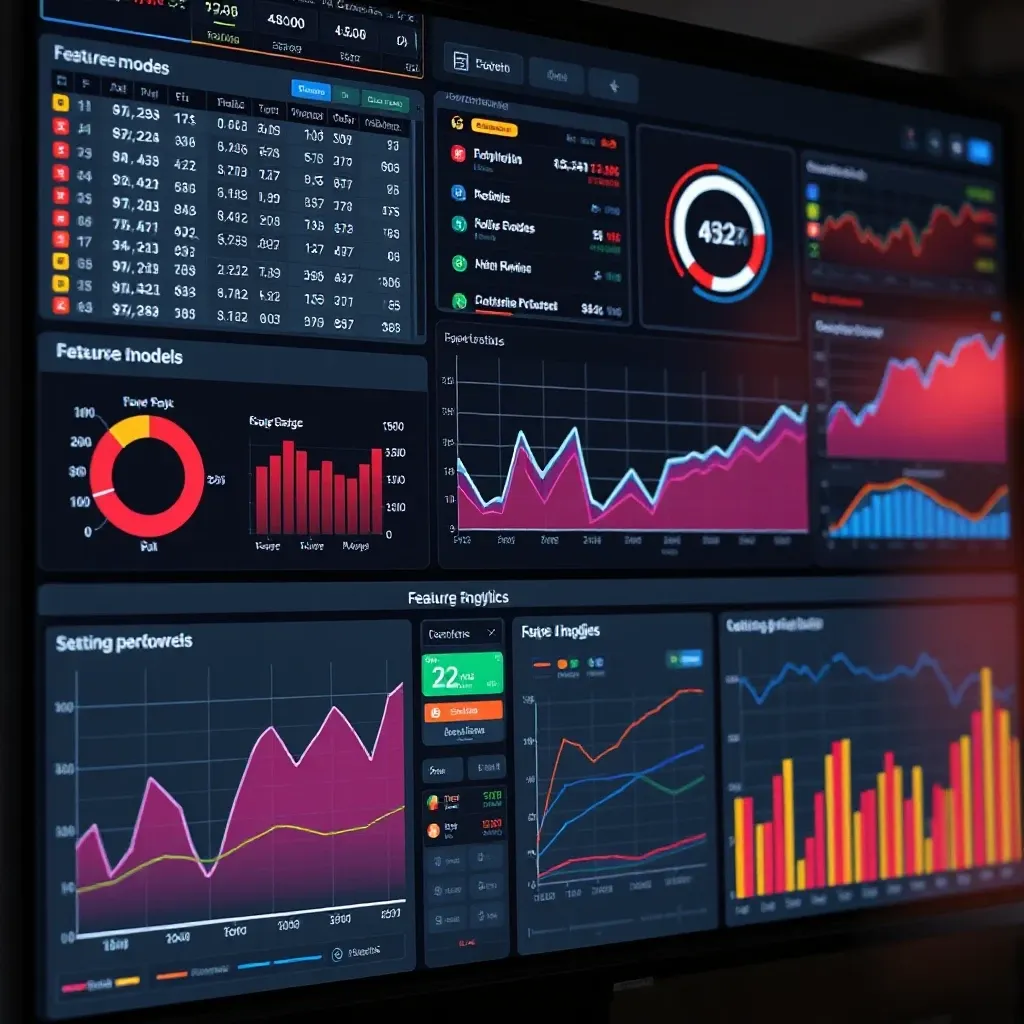Remember the days when placing a bet felt like flipping a coin, guided more by hunches and team loyalties than cold, hard facts? Those days are fading fast. The modern betting landscape has been revolutionized by betting analytics, a powerful tool that separates the informed from the hopeful. It’s no longer about simply knowing the game; it’s about understanding the underlying data that drives it.
Betting analytics offers a significant edge. This isn’t about replacing the thrill of the game. Instead, it’s about adding a layer of insight, transforming betting from a game of chance into a strategic pursuit. Today, data-driven betting isn’t just a trend; it’s the foundation of profitable betting for those who are serious. In this article, we’ll explore the tools and strategies used in betting analytics. Discover how you can leverage sports analytics to refine your betting strategy.
While betting analytics offers tremendous potential, it’s important to approach it with realistic expectations. No strategy, no matter how sophisticated, guarantees a win. However, by harnessing the power of data and understanding its implications, any bettor can significantly improve their odds and make more informed decisions. Let’s dive in and explore the exciting world of betting analytics.
The Power of Data in Betting: Why Analytics Matter
In the thrilling world of betting, success hinges on making informed decisions. Data analytics offers a significant edge, transforming intuition-based guesses into data-driven strategies. The advantages are clear: increased accuracy, smarter choices, and the potential for long-term profitability. With data analytics, bettors can meticulously track their performance, pinpoint emerging trends, and uncover hidden inefficiencies within the betting markets. This detailed approach allows for more effective risk management and the ability to seize opportunities that might otherwise go unnoticed. Imagine consistently making wagers backed by solid data, leading to a better return on investment (ROI) and a more sustainable betting strategy. Data-driven betting empowers you to play smarter, not harder, turning speculation into a calculated pursuit of profit.
Objective Decision Making
Emotions can be a bettor’s worst enemy. The thrill of a potential win or the sting of a recent loss can cloud judgment, leading to impulsive and often detrimental decisions. Betting analytics provides a powerful antidote to this emotional rollercoaster. By grounding choices in concrete data, bettors can bypass subjective feelings and make objective decisions. This means focusing on statistical probabilities, historical performance, and quantifiable factors rather than gut feelings or biases. By depersonalizing the betting process, analytics fosters a more rational and disciplined approach, ultimately improving the odds of success.
Pattern Recognition and Prediction
Successful betting isn’t just about luck; it’s about identifying patterns and predicting outcomes. Through diligent data collection and analysis of performance metrics, bettors can gain valuable analytical insights. These insights allow for the recognition of recurring trends and the prediction of future events with greater accuracy. This is especially crucial in complex betting scenarios where subtle patterns can be the key to unlocking profitable opportunities.
Essential Betting Analytics Every Bettor Should Know
To really get ahead in betting, you need to understand the numbers. This isn’t just about picking winners; it’s about evaluating the value of a wager. Seasoned bettors rely on key performance indicators (KPIs) to make informed decisions. Let’s break down the essential betting KPIs that can transform your approach. First, a vital element is expected value (EV), this shows the potential return of a bet over the long run. Then we have the Kelly Criterion, which guides optimal bet sizing for maximizing growth while managing risk. Yield and ROI (Return on Investment) are crucial for measuring overall profitability. Win rate, of course, tells you how often you’re picking correctly, and implied probability, derived from the odds, reveals what the bookmaker thinks the chances of an event occurring are. Each of these metrics gives you a different lens through which to assess a bet’s true worth. The idea is you make the most out of your bets and raise your chances of winning with time and experience.
Understanding Expected Value (EV)
Expected Value (EV) is the cornerstone of analytical betting. It quantifies the average amount you can expect to win (or lose) per bet if you were to repeat the same bet an infinite number of times. The formula is relatively straightforward: EV = (Probability of Winning Amount Won) – (Probability of Losing Amount Lost). So, if you’re betting on a outcome with a 50% chance to win $110 and a 50% chance to lose $100, your EV would be (0.5 $110) – (0.5 $100) = $5. This is a positive EV (+EV) bet. Consistently making +EV bets is about the “edge”. However, even with positive EV, variance exists. Short-term losses are still possible, but in the long run, a disciplined approach to +EV betting tends to lead to profitability.
Applying the Kelly Criterion
The Kelly Criterion is a formula that suggests the optimal percentage of your bankroll to bet on a particular outcome. The formula is: f = (bp – q) / b where: f = the fraction of your bankroll to bet, b = the net decimal odds received on the bet (e.g., decimal odds of 3.00, b = 2.00), p = the probability of winning, q = the probability of losing (1-p). The intention of this formula is to maximize the long-term growth rate of your bankroll. It is worth mentioning that over-betting, betting a larger percentage than the Kelly Criterion suggests, can lead to rapid depletion of your funds. This is why many bettors use a fractional Kelly approach (e.g., half Kelly), betting a fraction of the Kelly-recommended amount to reduce risk. Applying the Kelly Criterion is not simple as it seems, so, don’t YOLO with your strategy, be patience and remember to go little by little.

Tools and Resources for Betting Analytics
To really crush it in betting, you’ve gotta arm yourself with the right intel. That means diving deep into the world of betting analytics tools. Forget gut feelings; it’s all about data these days. Think of these tools as your secret weapon to spot opportunities and make smarter bets. Here’s a rundown of some essential categories to supercharge your betting game.
Data Collection APIs
Imagine having a firehose of real-time sports data piped directly into your systems. That’s the power of a sports data API. Instead of manually scraping websites (which is a pain, trust me), APIs give you instant access to scores, stats, and historical data. It’s huge for building your own models or integrating data into existing software. Sure, most decent APIs come with a price tag, reflecting the quality and speed of the data. But the time saved and the edge gained can make it well worth the investment. They automate the process and let you focus on actual analytics, not data entry. This is where it all begins, a decision that can make or break your entire operation.
Betting Analytics Software
Once you’ve got all that juicy data, you need a way to make sense of it. That’s where betting analytics software comes in. We’re talking about everything from tricked-out Excel spreadsheets to full-blown analytics platforms. The best ones let you visualize data, track your bets, and analyze your performance. You can run statistical tests, identify trends, and basically become a betting data wizard. Many platforms offer customizable dashboards, meaning you can see the metrics that matter most to you. Some software comes with a steep learning curve, but mastering it opens doors to serious insights.
Building Your Own Betting Model
Creating a betting model might seem intimidating, but it’s entirely achievable without needing to be a coding whiz. The core idea revolves around building a predictive model using time-tested statistical methods and readily available data analysis tools. It’s all about forecasting potential outcomes based on historical information. Think of it as a refined, data-driven approach to making informed wagers. The process is iterative. As you gather more data and refine your techniques, the accuracy of your predictions improves exponentially.
Here’s a simplified roadmap to get you started:
- Define the Objective: What exactly are you trying to predict? Is it the final score of a game, the number of goals scored, or something else entirely?
- Gather Data: Accumulate as much historical data as possible related to your objective. This could include team statistics, player performance, weather conditions, and more.
- Select Your Variables: Determine which statistics are most likely to influence the outcome you’re predicting. Not all data is created equal.
- Choose a Method: Start with a simple method like regression analysis using a tool such as Microsoft Excel. This helps establish a baseline understanding.
- Test and Refine: This is where the real magic happens. Evaluate your model’s performance using historical data and identify areas for improvement.
For example, in Excel, you could use the regression function to predict the points scored by a basketball team based on variables like field goal percentage, three-point percentage, and free throw percentage. By inputting historical data and running the regression, you’ll obtain an equation that estimates the relationship between these variables and the points scored. In that moment you will see what the numbers shows you.
Selecting Relevant Variables
Choosing the right variables is crucial. Focus on those demonstrably linked to the outcome you’re predicting. Be wary of spurious correlations, which look connected but lack a logical relationship. For example, ice cream sales might correlate with crime rates, but one doesn’t cause the other. Cleaning and pre-processing your data eliminates errors and inconsistencies, boosting your model’s reliability. This process, known as feature selection or assessing variable importance, ensures that your model is built on a solid foundation of meaningful information.
Backtesting & Model Validation
Backtesting is putting your model to the test. Use historical data to simulate placing bets based on your model’s predictions. Analyze the results like profit/loss and return on investment (ROI) to determine its effectiveness. Beware of overfitting, where the model performs well on historical data but poorly on new data. Out-of-sample testing, using data that wasn’t used to build the model, is essential to ensure its real-world applicability. This rigorous validation process helps to refine accuracy and avoid costly errors.
Interpreting the Data: Avoiding Common Pitfalls
Data interpretation can feel like navigating a minefield if you are not careful. Jumping to conclusions, cherry-picking data to support a pre-existing belief, or simply misreading the numbers can lead to costly mistakes. Confirmation bias, where you only seek out information that confirms what you already believe, is a common trap. Overfitting can also be an issue. It is when a model is too complex. That also captures noise in the data, leading to poor predictions on new data. Developing critical thinking skills and understanding basic statistical principles are essential for sound data interpretation. These allow for a confident decision-making.
The Dangers of Small Sample Sizes
Drawing conclusions from small samples is a classic error. Imagine you are analyzing the success rate of a new basketball free-throw technique, but you only observe five attempts. If four are successful, can you confidently claim an 80% success rate? Probably not. Small samples are highly susceptible to random variation. Therefore, it can produce skewed results that do not accurately reflect the true population proportion. To mitigate this, strive for larger, more representative data sets. If that is not possible, explore statistical methods designed for small samples, such as Bayesian statistics, which can incorporate prior knowledge to improve the robustness of your analysis.
Correlation vs. Causation
Just because two things appear to be related does not mean one causes the other. This is the crux of the “correlation versus causation” dilemma. A spurious correlation might be where two completely unrelated variables appear to move together simply by chance. For instance, you might find a correlation between the number of times a commentator mentions a team and the team’s likelihood of winning. However, the commentator’s mentions probably have nothing to do with the team’s victory. To dig deeper, consider factors through regression analysis and look for experiments that isolate and manipulate variables to establish causal links more convincingly.

Putting Analytics into Action: Developing Profitable Betting Strategies
Value Betting Strategies
Finding value in betting is all about spotting when the odds offered by a bookmaker don’t truly reflect the real chance of something happening. It starts with forming your own view on how likely an event is – your subjective probability. Then, you convert the betting odds into an implied probability (what the bookmaker thinks the chances are). If your probability is higher than the implied probability, you’ve potentially found a value bet. This means the expected value – what you stand to gain versus what you risk – is positive. Scouring different sportsbooks for “soft lines” (odds that haven’t been as sharply priced) helps find these discrepancies. Refining your probability estimations comes with experience and access to more data.
Arbitrage Opportunities
Arbitrage betting, sometimes called “sure betting,” is about exploiting differences in odds offered by different sportsbooks or betting exchanges to guarantee a risk-free profit. This involves placing bets on all possible outcomes of an event across different platforms, ensuring a return no matter the result. For example, if one sportsbook offers high odds on Team A to win, while another offers good odds on Team B, a smart bettor can cover all bases and pocket the difference. Discovering such situations requires constant odds comparison and rapid action, as these market opportunities tend to disappear quickly. While it sounds foolproof, be aware that bookmakers can void bets or limit accounts of those suspected of arbitrage.
The Future of Betting Analytics and How to Stay Ahead
The world of betting is in constant flux, driven by technological advancements and an ever-increasing hunger for data. To remain competitive, or even just proactive, continuous learning and adaptation are essential. The future of betting hinges on embracing emerging trends in statistics and analytics, transforming how wagers are placed and outcomes are predicted.
Machine Learning
Machine learning, including deep learning and AI-driven neural networks, is rapidly changing the landscape. One significant advantage lies in the ability to create more robust predictive models by leveraging big data from different leagues and sources. These models can identify patterns and correlations that would be impossible for humans to detect, ultimately leading to more informed betting strategies. The increasing availability of data makes machine learning indispensable.
Data Visualization
The accessibility of data is one thing and the interpretation is another. Data visualization provides clarity through visual reports and dashboards. Transforming complex data sets into easily understandable charts and graphs enhances the capability to identify key market trends and potential opportunities. The impact of data visualization is making data-driven strategies more accessible than ever.
Conclusion: Embrace Data, Bet Responsibly
In conclusion, betting analytics serves as a compass, guiding individuals through the intricate landscape of sports betting. By harnessing the power of data, bettors gain a competitive edge, unearthing valuable insights that inform strategic decisions. From pinpointing profitable opportunities to managing risk effectively, the benefits are undeniable. However, it’s crucial to remember that data is a tool, not a crystal ball. It enhances one’s understanding, but doesn’t guarantee wins. The human element – intuition, passion, and a love for the game – remains integral.
Ultimately, smart betting hinges on informed decisions coupled with responsible practices. Embrace the data, but always wager within your means, set clear limits, and prioritize your well-being.
Responsible Gambling Measures
Financial irresponsibility can quickly turn a recreational activity into a source of stress and anxiety. To prevent this, implement responsible gambling measures. Set a budget before you start and stick to it. Consider using self-exclusion programs offered by betting platforms and explore risk-free bet options to minimize potential losses. Remember, gamification should not come at the expense of your personal finance.
